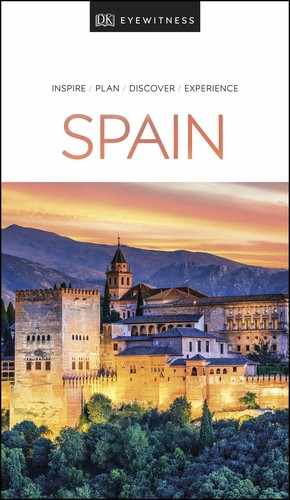Experience More
Just inside the border with France, the Somport Pass was for centuries a strategic crossing point for the Romans and Moors, and for medieval pilgrims en route to Santiago de Compostela. Today the austere scenery is specked with ski resorts. Astún is modern and well organized, while El Formigal is a stylish, purpose-built resort. Non-skiers can enjoy the scenery around the Panticosa gorge. Sallent de Gállego is popular for rock climbing and fishing.
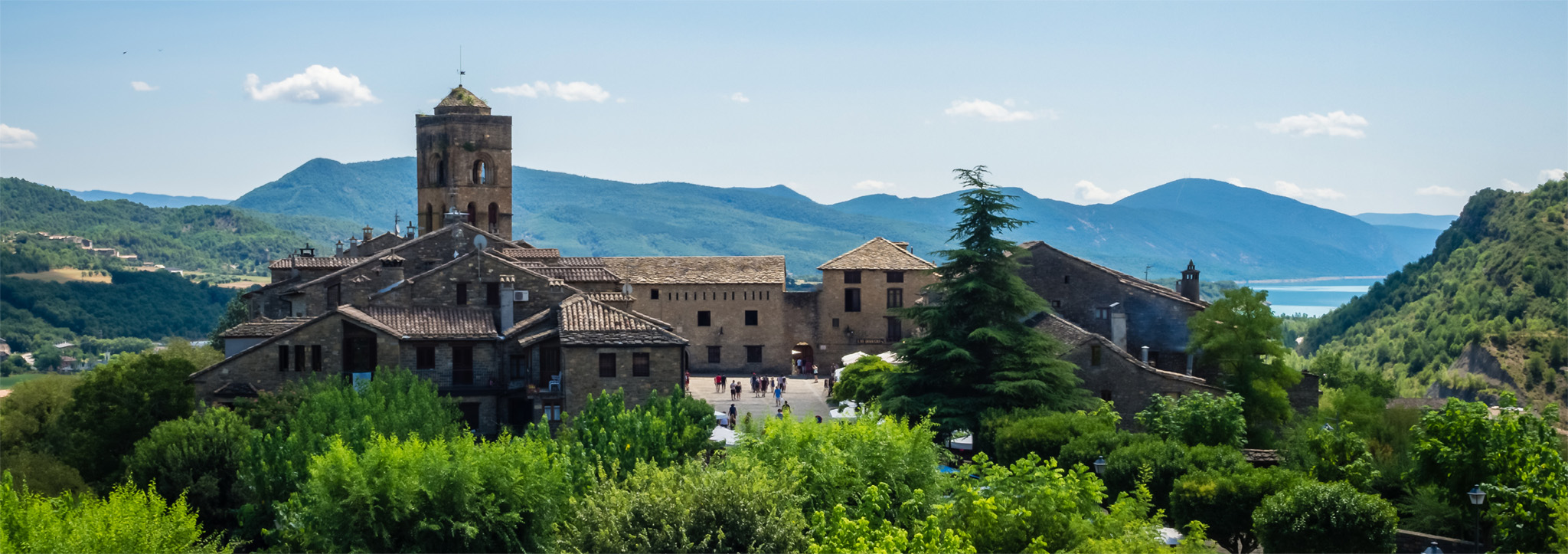
t The hilltop village of Aínsa, surrounded by wooded hills
The capital of the kingdom of Sobrarbe in medieval times, Aínsa has retained its charm. Plaza Mayor, a broad cobbled square, is surrounded by neat terraced arcades of brown stone. On one side is the belfry of the Iglesia de Santa María – consecrated in 1181 – and on the other the restored castle.
The delightful valleys of Ansó and Hecho, formed by the Veral and Aragón Subordán rivers respectively, were once isolated due to poor road links, enabling their villages to retain traditional customs and a local dialect called Cheso. Now the area’s crafts and costumes have made it popular with tourists. The Pyrenean foothills and forests above the valleys are good for walking, fishing and cross-country skiing.
Ansó lies in the prettiest valley, which becomes a shadowy gorge where the Río Veral squeezes between vertical crags. Many of its buildings have stone façades and steep, tiled roofs. The 16th-century church has a museum dedicated to local costume. Pieces of modern sculpture lie scattered beside the tourist information office, from an open-air festival once held here.
Tucked away in the northeast corner of Aragón, at the head of the Esera Valley, the village of Benasque presides over a ruggedly beautiful stretch of Pyrenean scenery. Although the village has expanded greatly to meet the needs of the holiday trade, a sympathetic use of wood and stone has resulted in buildings that complement the existing older houses. It is well worth a stroll through the old centre, which is filled with delightful aristocratic mansions and other striking buildings. Look out for the 13th-century Iglesia de Santa María Mayor and the Palacio de los Condes de Ribagorza. The latter has a Renaissance façade.
Above the village rises the Maladeta massif. There are magnificent views from its ski slopes and hiking trails.
For walkers, skiers and climbers, the area around Benasque has a great deal to offer. The neighbouring resort of Aramón Cerler was developed with care from a rustic village into a popular base for skiing and other winter sports.
At Castejón de Sos, 14 km (9 miles) south of Benasque, the road passes through the Congosto de Ventamillo, a scenic rocky gorge.

Picture Perfect
Peak-a-Boo
For €1, you can climb the tower of Aínsa’s Iglesia de Santa Maria. This is the perfect vantage point to snap a dramatic photograph of the Peña Montañesa mountain, framed by the stone window, that looms over the town.
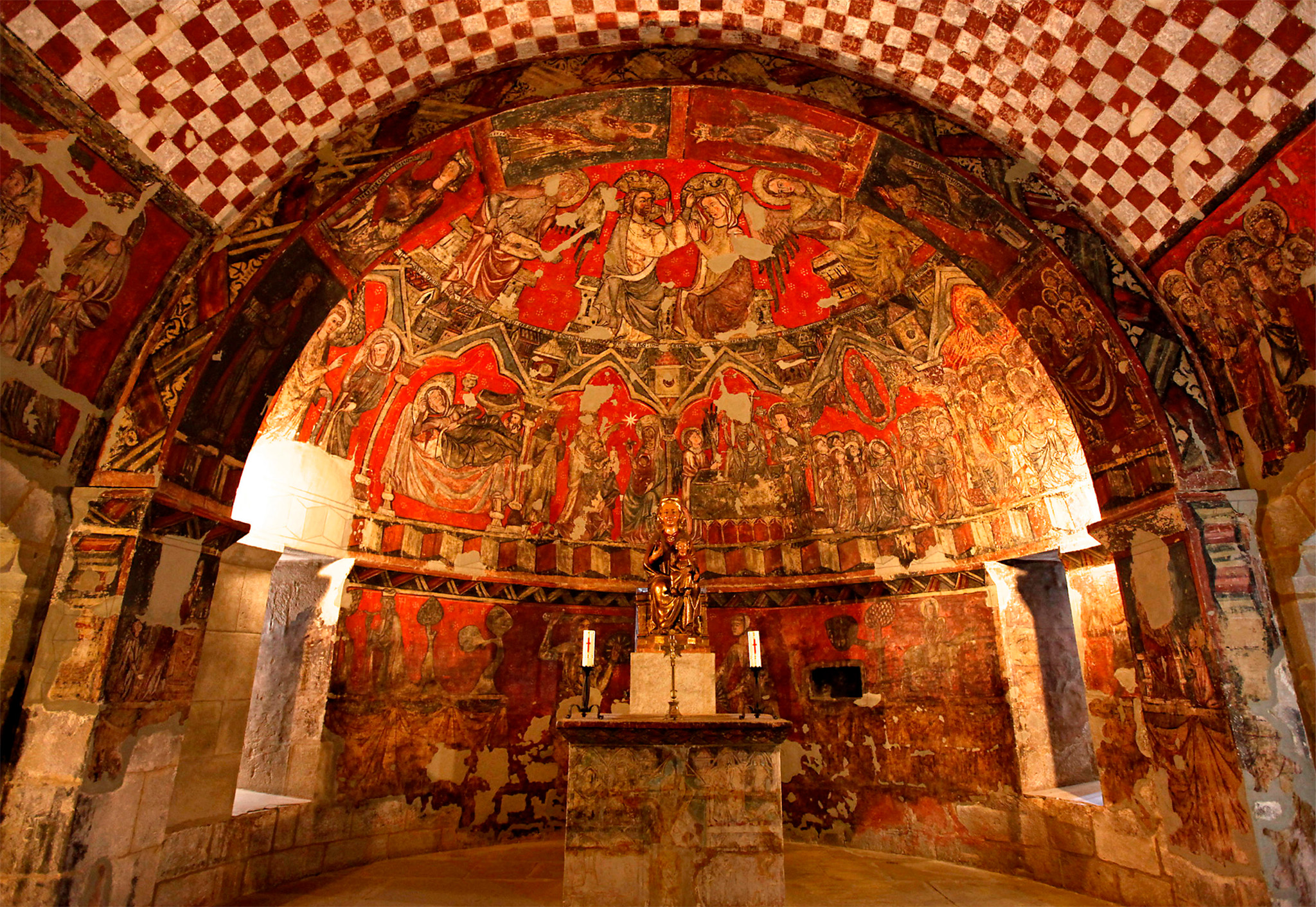
t The crypt of the Iglesia de San Esteban at Sos del Rey CatÓlico
Fernando of Aragón – the so-called “Catholic King” who married Isabel of Castile and León, thereby uniting Spain – was born in this small town in 1452, thus its distinguished royal name.
The Palacio de Sada, the king’s reputed birthplace, is among the town’s grandest stone mansions. It stands in a small square amid a maze of narrow cobbled streets. At the top of the town are the remnants of a castle and the Iglesia de San Esteban. The church’s font and carved capitals are noteworthy, as are the 13th-century frescoes in two of the crypt’s apses. From here there are fine views over the surrounding hills.
The Gothic-arched Lonja (commodities exchange) and the 16th-century town hall (ayuntamiento) are located on the adjacent main square.
EXPERIENCE Aragón
|
EAT El Origen Old meets new at this central Huesca spot, which is committed to Aragonese cuisine. All of the ingredients are responsibly sourced. ⌂ Plaza de la Justicia 4, Huesca ∑ elorigenhuesca.com ¡¡¡ Casa Pardina Tucked away in the village of Alquézar, this friendly restaurant offers a varied menu in a typical Spanish setting – it’s draped in olive trees and looks out onto a hillside of tiered houses. ⌂ Calle Medio, Alquézar ∑ casapardina.com ¡¡¡ La Parilla With an old-fashioned exterior, this Benasque eatery offers top-quality food in a charming setting. ⌂ Carretera Francia s/n, Benasque § 974 55 11 341 ¡¡¡ |
In the 8th century the people in this town bravely repulsed the Moors – an act which is commemorated in the festival of La Victoria – and in 1035 became the first capital of the kingdom of Aragón. Jaca’s 11th-century cathedral, one of Spain’s oldest, is much altered inside. Traces of its original splendour can be seen on the restored south porch and doorway, where carvings depict biblical scenes. The dim nave and chapels are decorated with ornate vaulting and sculpture. A museum of sacred art, in the cloisters, contains a collection of Romanesque and Gothic frescoes and sculptures from local churches. The streets that surround the cathedral form an attractive quarter.
Jaca’s only other significant sight is its 16th-century citadel, a fort decorated with corner turrets. Today the town is often used as a base for exploring the Aragonese Pyrenees.

t The striking cloister of the Monasterio de San Juan de la Peña
Partially carved into a cliff, this monastery is said to have been an early guardian of the Holy Grail. In the 11th century it underwent reformation, and was the first monastery to introduce the Latin Mass in Spain. After a fire in the 1600s, the building was abandoned in favour of a newer one further up the hillside. This was later sacked by Napoleon’s troops. It now houses an interpretation centre and hotel.
The church belonging to the old monastery is on two floors. The lower one is a primitive 10th-century rock-hewn crypt while the upper floor contains an 11th-century church with a triple apse hollowed out of the side of the cliff. Here, the Romanesque pantheon contains the stacked tombs of the early Aragonese kings. The exterior cloister is San Juan de la Peña’s pièce de résistance, the capitals of its columns carved with biblical scenes.
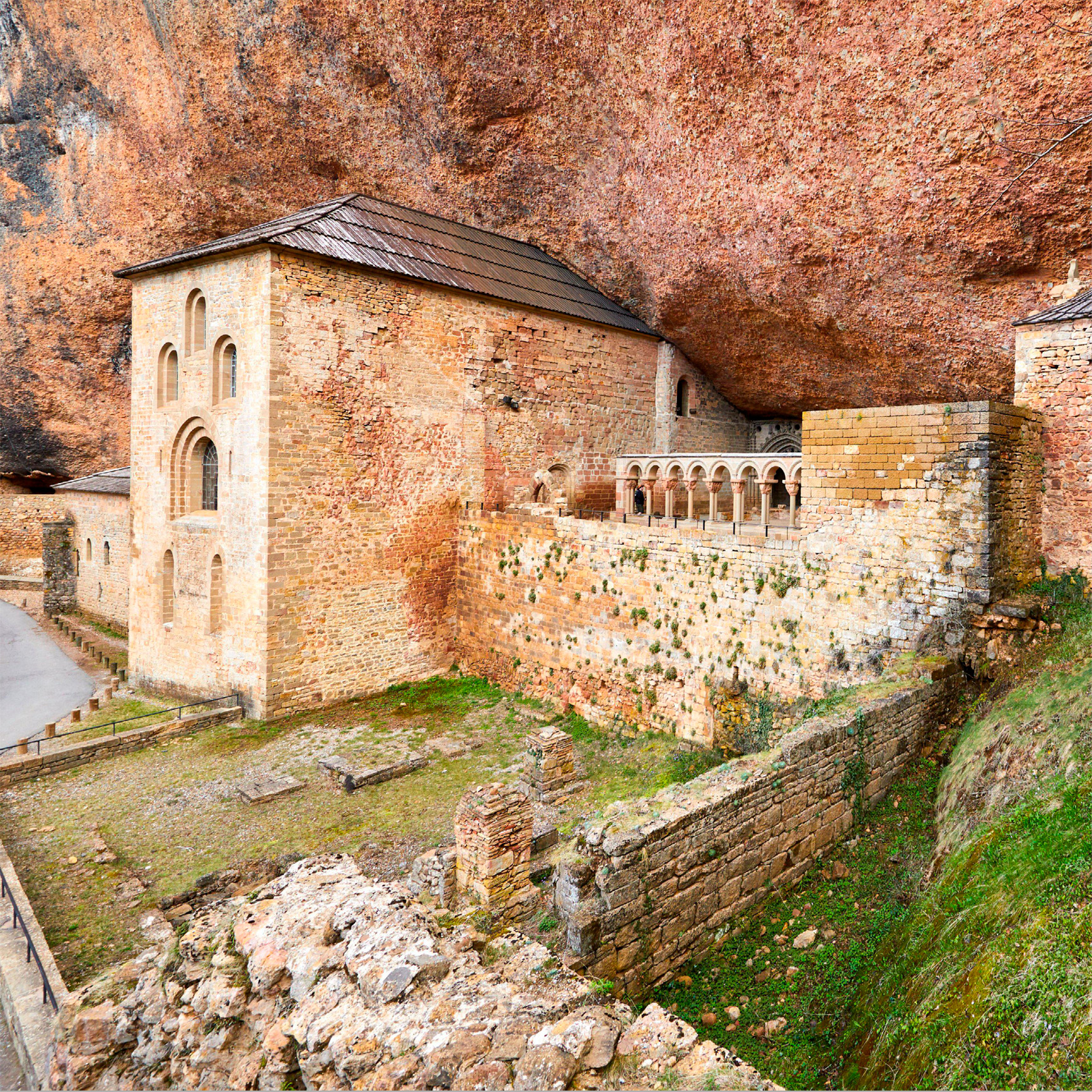
t Hollowed into a cliff
The Moorish village of Alquézar attracts much attention because of its spectacular setting. Its main monument, the stately 16th-century collegiate church, dominates a hill jutting above the strange rock formations of the canyon of the Río Vero. Inside, the church’s cloisters have capitals carved with biblical scenes. Next to it is the chapel built after Sancho I recaptured Alquézar from the Moors. Nearby are the ruined walls of the original alcázar, which gave the village its name.
The ramparts of this fortress stand majestically above the road from Ayerbe. The fortress is so closely moulded around the contours of a rock that in poor visibility it could be easily mistaken for a natural outcrop. It was used as a set for Ridley Scott’s film Kingdom of Heaven (2005). On a clear day, the hilltop setting is stupendous, with views of surrounding orchards and reservoirs.
Inside the curtain walls is a complex founded in the 11th century on the site of what had originally been a Roman settlement. It was later remodelled under Sancho I (Sancho Ramírez) of Aragón, who established a religious community here, placing the complex under the rule of the Order of St Augustine. Within the castle walls is a Romanesque church. Sentry paths, iron ladders and flights of steps ramble precariously around the castle’s towers, dungeons and keep.
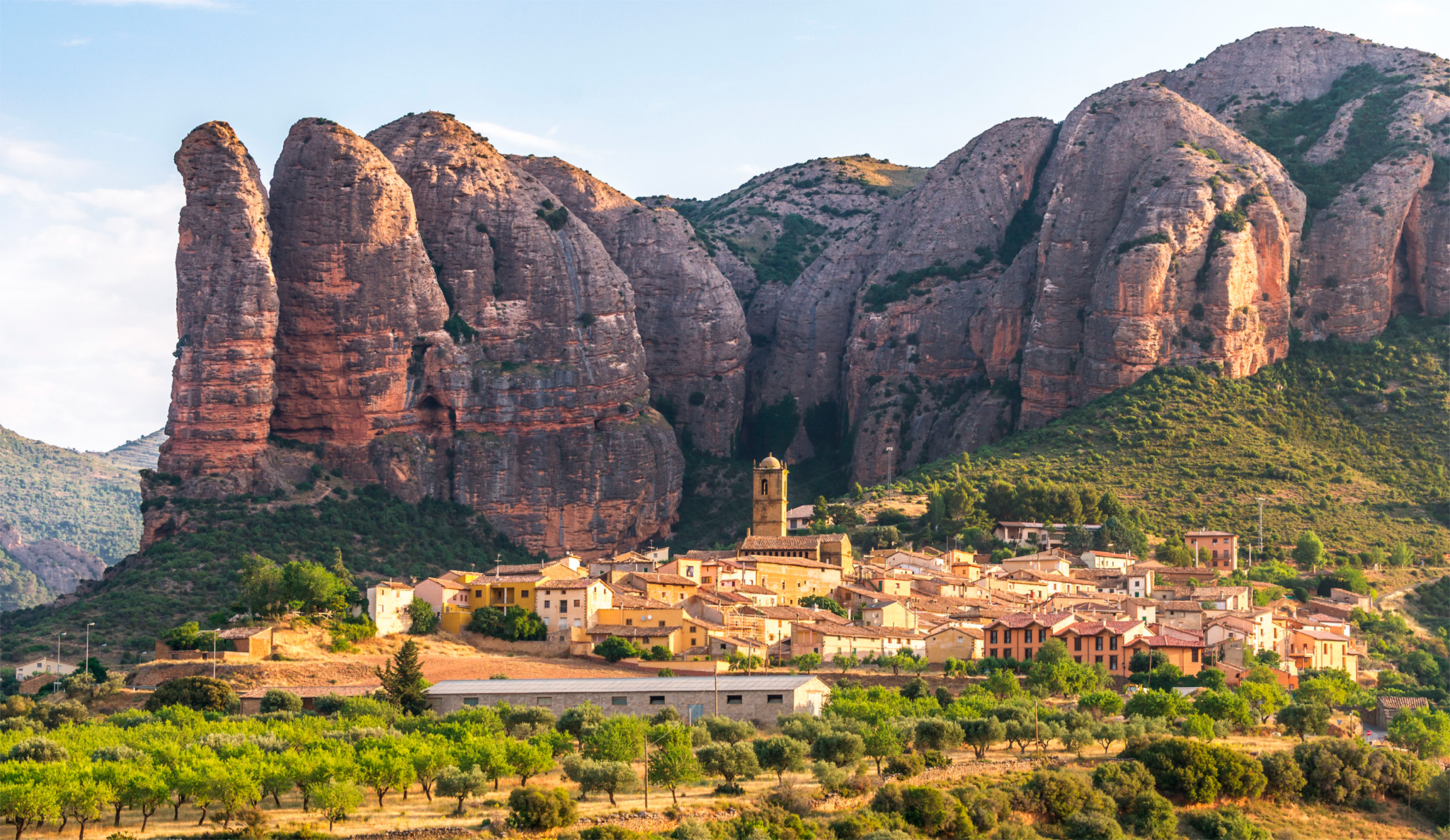
t The small town of Agüero, sat at the foot of the Mallos rock formation
The picturesque setting of this attractive village, clustered against a dramatic crag of eroded pudding rock known as the Mallos de Agüero, amply rewards a brief detour from the main road. As you wander around the village, the rocks are always visible, providing a wonderful backdrop.
The most important reason for visiting Agüero, however, is to see the 12th-century Iglesia de Santiago. This Romanesque church is reached by a long stony track leading uphill just before the village.
The capitals of the columns in this unusual triple-naved building are carved with fantastical beasts as well as scenes from the life of Jesus and the Virgin Mary. The beautiful carvings on the doorway display biblical events, including scenes from the Epiphany and Salome dancing ecstatically. The lively, large-eyed figures are attributed to the mason responsible for the superb carvings in the monastery at San Juan de la Peña.
EXPERIENCE Aragón
|
Stay Apartamentos La Luna These apartments are close to all of Sos del Rey Católico’s amenities and local sights. ⌂ Calle Luna 8, Sos del Rey Católico § 666 66 17 20 ¡¡¡ Hotel Sancho Abarca Hotel with a spa at the heart of Huesca. Great value for money. ⌂ Calle Coso Alto 52, Huesca ∑ hotelsanchoabarca.com ¡¡¡ Apartahotel & Spa Jacetania These Jaca apartments make a great base, especially for families. ⌂ Doctor Maranon 5, Jaca ∑ ahjacetania.es ¡¡¡ |

t Attractive buildings towering over Tarazona's tree-lined streets
Mudéjar towers stand high above the earth-coloured, mottled roofs of the ancient bishopric of Tarazona. On the outskirts of the Old Town is the cathedral, all turreted finials and pierced brickwork with Moorish cloister tracery and Gothic tombs.
In the upper town on the other side of the river, more churches, in typical Mudéjar style, can be found amid the maze of narrow hilly streets. More unusual perhaps are the former bullring, now a circular plaza enclosed by houses, and the splendid Renaissance ayuntamiento (town hall). The town hall, built of golden stone, has a façade carved with mythical giants and a frieze showing Carlos I’s homage to Tarazona. The unique Gothic cathedral has a Baroque façade and Mudéjar towers.
Did You Know?
On 27 August, a ”harlequin” tries to cross Tarazona’s plaza while being pelted with tomatoes.
In the heart of Graus’s Old Town is the unusual Plaza de España, surrounded by stone arcades and columns. It has brightly frescoed half-timbered houses and a 16th-century city hall. The home of Tomás de Torquemada, the Inquisitor General, is in the narrow streets of the old quarter. During mid-September, these streets serve as the stage for traditional Aragonese dancing during Graus’s fiesta.
Founded in the 1st century BC, the independent state of Osca (Huesca) had a senate and an advanced education system. From the 8th century AD, the area grew into a Moorish stronghold.
Huesca is now the provincial capital. The pleasant Old Town has a Gothic cathedral, with an eroded west front surmounted by an unusual wooden gallery in Mudéjar style. Above the nave is slender-ribbed star vaulting studded with golden bosses. An alabaster altarpiece, by the master sculptor Damià Forment has a series of Crucifixion scenes in relief, highlighted by illumination.
Opposite the cathedral is the fortress-like Renaissance ayuntamiento. Inside hangs La Campana de Huesca, a gory 19th-century painting depicting the town’s most infamous event: the beheading of a group of troublesome nobles in the 12th century by order of King Ramiro II. The massacre occurred in the former Palacio de los Reyes de Aragón, later the university and now the superb Museo de Huesca, containing archaeological finds and a collection of art.
Museo de Huesca
⌂ Plaza de la Universidad 1 § 974 22 05 86 # 10am–2pm & 5–8pm Tue–Sat, 10am–2pm Sun & public hols ¢ 1 & 6 Jan, 24, 25 & 31 Dec
This shrine was built to honour the founder of the Catholic lay order of Opus Dei – San Jose María Escrivá de Balaguer. It occupies a promontory with picturesque views. The huge church is made of red brick in a stark, modern design.
Inside, there is a surprisingly elaborate altarpiece, sheltering a glittering Romanesque Virgin, which sits in contrast to the bleak, functional nave.
Barbastro, 30 km (18 miles) to the south, has an arcaded plaza mayor and a 16th-century cathedral with an altar by Damià Forment.
This Cistercian retreat, set in the green Huecha Valley near the Sierra de Moncayo, is one of the greatest monasteries in Aragón. Founded in the 12th century by French monks, the huge abbey church has a mixture of Romanesque and Gothic features. Worn green and blue Aragonese tiles line the floor of its handsomely vaulted triple nave. The well-preserved cloisters sprout exuberantly decorated beasts, busts and foliage in the Gothic style. The plain, dignified chambers make a suitable venue for art exhibitions in the summer.
In the hills to the west, the Parque Natural de Moncayo rises 2,315 m (7,600 ft). Streams race through the woodland of this nature reserve, which abounds with bird life.
EXPERIENCE Aragón

Aragón Fiestas
La Tamboradas
In Teruel, during Easter week, brotherhoods of men in black robes beat drums in a dramatic display of mourning.
Carnival
During this spring fiesta in Bielsa, in the Parque Nacional de Ordesa, men dress as Trangas. They paint their faces black and wear rams’ horns on their heads.
Romería de Santa Orosia
Pilgrims carry St Orosia’s skull to her shrine in Yebra de Basa, near Jaca, on 25 June.
Día del Pilar
Aragón’s folk dance, the jota, is performed during Zaragoza’s festivities in honour of its patroness, the Virgin of the Pillar.
Nestled in the midst of the Sistema Ibérico mountain range, Calatayud’s huge Moorish fortress and minaret-like church towers are visible from miles around. Only ruins are left of the 8th-century Arab castle of the ruler, Ayub, which gave the town its name.
The church of Santa María la Mayor features a Mudéjar tower and an elaborate façade in the Plateresque style. The 17th-century church of San Juan Real contains some Goya paintings.
The ruins of the Roman settlement of Bílbilis are east of Calatayud, near Huérmeda.

t The Mudéjar tower of the church of San Juan Real, Calatayud
An impressive array of battle-mented medieval walls stretches approximately 4 km (2 miles) around this old Moorish stronghold. Although parts of the walls have decayed, some of the 114 towers and gateways are still a remarkable sight, particularly from the main road to Zaragoza.
The Colegial de Santa María, a church in the Plaza España, houses the Holy Cloths from the Reconquest. After a surprise attack by the Moors in 1239, priests celebrating Mass bundled the consecrated bread into the linen sheets used for the altar. Upon being unwrapped, the cloths were said to be miraculously stained with blood.
The agricultural town of Monreal del Campo, 42 km (26 miles) south of Daroca, has a saffron museum, celebrating the local crop.
Two buildings rise above the town of Alcañiz. One is the castle, once the headquarters of the Order of Calatrava. This historic building has been converted into a parador. The keep, the Torre del Homenaje, has a collection of 14th-century frescoes depicting the conquest of Valencia by Jaime I.
The other building is the Iglesia de Santa María. This church, on the sloping Plaza de España, has a Gothic tower and a Baroque façade.
On the same square are the elegantly galleried Lonja (commodities exchange), with its lacy Gothic arches, and the town hall (ayuntamiento), which has one Mudéjar and one Renaissance façade.
Francisco de Goya
Born in Fuendetodos in 1746, Francisco de Goya specialized in designing cartoons for the tapestry industry in his early life, and in decorating churches such as Zaragoza’s Basílica del Pilar with vivacious frescoes. In 1799 he became painter to Carlos IV, and depicted the king and his wife María Luisa with unflattering accuracy. The invasion of Madrid by Napoleon’s troops in 1808 and its attendant horrors had a profound and lasting effect on Goya’s temperament, and his later works are imbued with cynical despair and isolation. He died in Bordeaux in 1828.
This small village was the birthplace of one of Spain’s best-known artists, Francisco de Goya. The Casa-Museo de Goya is a cottage said to have been the painter’s home. It has been furnished in an early 19th-century style.
In Cariñena, 25 km (16 miles) west of Fuendetodos, bodegas offer the opportunity to sample and buy the excellent, full-bodied red wine for which the region is justly renowned.
"
Casa-Museo de Goya
⌂ Calle Zuloaga 3 § 976 14 38 47 # 11am–2pm & 4–7pm Tue–Sun

t Espejo Lake, located in the park of the Monasterio de Piedra
Built on the site of a Moorish castle conquered by Alfonso II of Aragón and given to Cistercian monks in the 12th century, this monastery was damaged in the 19th century and subsequently rebuilt. Some 12th-century buildings remain, including the chapterhouse, refectory and hostel.
In the damp cellars, the monks once distilled herbal liqueur. This was allegedly the first place in Europe where drinking chocolate was made, and there is now an exhibition on all things chocolate here.
The park in which the monastery stands is a nature reserve full of grottoes and waterfalls. A hotel and spa is now located in the old monastery buildings.

Hidden Gem
Memories of War
Lying 14 km (9 miles) east of Fuendetodos is Belchite, site of one of the most horrific battles of the Spanish Civil War, when factions fought for control of the strategic Ebro Valley. Remains of the shell-torn town have been left as a monument to the horrors of war.
Just inside Aragón’s border with Catalonia, the town of Valderrobres overlooks the trout-filled Río Matarraña. Dominating the town is the Castillo de Valderrobres, formerly a grand palace for Aragonese royalty. Below this hollow structure stands the imposing Gothic Iglesia de Santa María la Mayor, with a huge rose window in Catalan Gothic style. The arcaded plaza in which it stands has a pleasing late 16th-century town hall.
Near Valderrobres is the mountain peak of La Caixa. Located 14 km (9 miles) from the town are the mountain passes of Beceite.
" '
Castillo de Valderrobres
§ 679 63 44 38 # Hours vary, call ahead

t Mudéjar-style towers at the top of the Escalinata staircase in Teruel
This industrial city has been the scene of much desperate fighting throughout the centuries, beginning with the Romans, the first to capture and civilize Celtiberian Turba.
During the Reconquest, Teruel became a strategic frontier prize. In 1171 Alfonso II recaptured Teruel for Christian Spain, but many Moors continued to live peacefully in the city, which they embellished with beautiful Mudéjar towers. The last mosque was closed only at the height of the Inquisition, in 1502.
The old quarter is home to the wedge-shaped Plaza del Torico, with a monument of a small bull, the city’s emblem. Within walking distance lie the five remaining Mudéjar towers. Most striking are those of San Salvador and San Martín, both dating back to the 12th century. The latter has multi-patterned brickwork studded with blue and green ceramics. Nearby, the grand Escalinata is also crowned with Mudéjar towers, but this staircase was actually built in 1920.
The cathedral has more colourful Mudéjar work, including a lantern dome of glazed tiles, and a tower completed in the 17th century. But the tombs of the famous Lovers of Teruel are beside the Iglesia de San Pedro, rather than the cathedral.
The Museo Provincial houses a large collection of ceramics, testifying to an industry for which Teruel has long been known.
Museo Provincial
⌂ Plaza Fray Anselmo Polanco 3 # 10am–2pm & 4–7pm Tue–Sun ∑ museo.deteruel.es
1937
The Civil War’s bitterest battle was fought in Teruel during this freezing winter.
The Lovers of Teruel
According to legend, in 13th-century Teruel, Diego de Marcilla and Isabel de Segura wished to marry but her wealthy family forbade the match because he was poor. Diego was given five years to make his fortune. When he returned to Teruel, laden with wealth, he found Isabel already married. Diego died of a broken heart and Isabel died the following day. The Bodas de Isabel de Segura, a festival in February, re-enacts the events.
This range of hills, northeast of Teruel, is a region of pine woods, jagged limestone outcrops and scrub-covered slopes. At 2,028 m (6,653 ft), Peñarroya is the highest point. Nearby Valdelinares, Spain’s highest village, is a ski station. From the access roads there are panoramic views of the hills. Especially noteworthy are the views from the towns of Linares de Mora and Alcalá de la Selva, which has a castle set against a backdrop of rock faces. Its Gothic-Renaissance church, with shell motifs and twisted columns, shelters the shrine of the Virgen de la Vega.
This remote enclave south of Teruel belongs to the Comunidad Valenciana, but is effectively an island of territory, stranded between the borders of Aragón and Castilla-La Mancha. The area has not prospered in modern times, but still has an austere charm and peaceful tracts of country scattered with red rocks.
A dramatic cliff above the Río Guadalaviar is the ideal setting for this attractive cluster of mellow pink buildings. Standing on a ridge behind the town are defensive walls and towers from Moorish times.
There is a good view of the town from below the Palacio Episcopal (Bishop’s Palace). Inside the neighbouring 16th-century cathedral, which is topped by a belfry, there is a Renaissance carved wooden altarpiece depicting scenes from the life of St Peter. The treasury museum contains 16th-century Brussels tapestries and enamelled chalices.
Some of Albarracín’s sturdy beamed and galleried houses have an unusual two-tier structure. The ground floor is limestone, and the overhanging upper storey is covered in rough coral-pink plasterwork. Many have been restored to their medieval form. Just outside the town are the caves of Navazo and Callejón, with their prehistoric rock paintings. Reproductions can be seen in Teruel’s Museo Provincial.
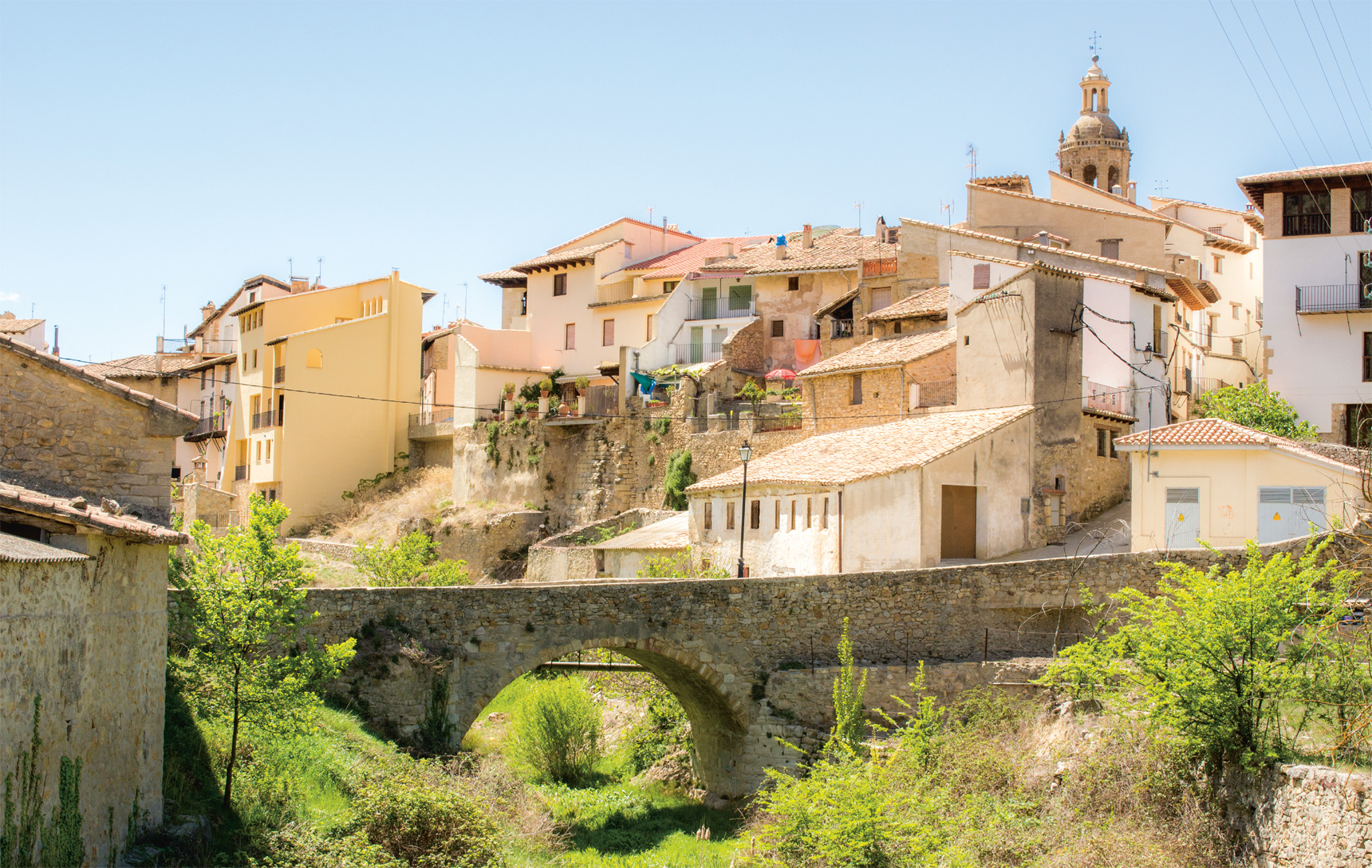
t Stone dwellings clinging to the hillside in the village of Rubielos de Mora
Dominated by one of the best-preserved castles in Aragón, the municipality of Mora de Rubielos retains the remains of the old walled city, and a medieval Old Town. Most noteworthy are the fine 17th-century town hall and the church of Santa María.
Rubielos de Mora, 14 km (9 miles) to the southeast, is worth exploring for its well-preserved stone and timber buildings. Among the houses is an Augustinian convent with a Gothic reredos.
EXPERIENCE Aragón
|
Eat Meseguer Great service and delicious food come together in this chic restaurant. For the best deals, order from the tasting or set menus. ⌂ Avenida Maestrazgo 9, Alcañiz ∑ meseguer.info ¡¡¡ Tiempo de Ensueño Perfect for special occasions, or if you fancy a treat, this upscale restaurant has a menu of traditional cuisine, with interesting twists. ⌂ Calle Palacios 1B, Albarracín ∑ tiempodeensuenyo.com ¡¡¡ |
